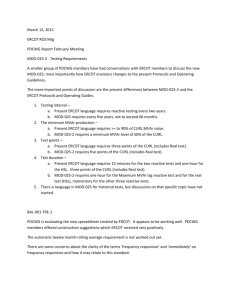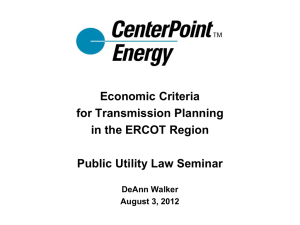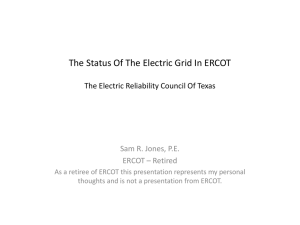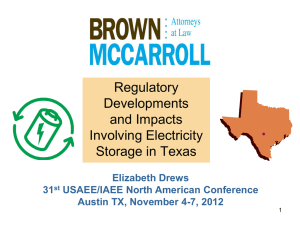540NPRR-14 CenterPoint Energy Comments 081313
advertisement
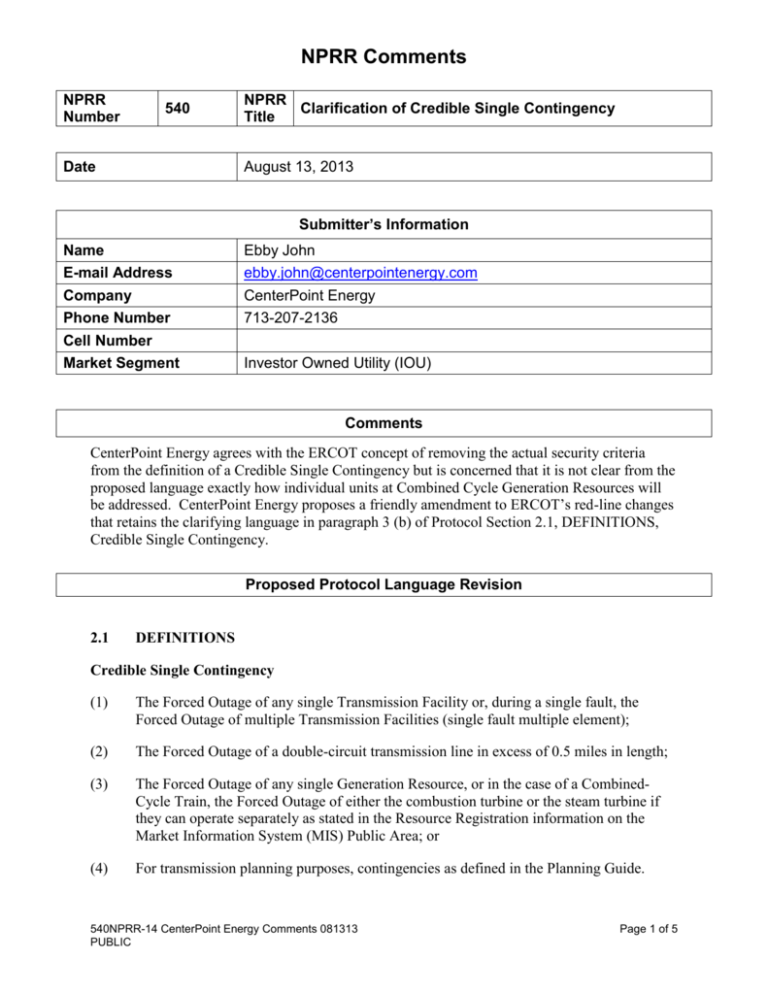
NPRR Comments NPRR Number 540 Date NPRR Clarification of Credible Single Contingency Title August 13, 2013 Submitter’s Information Name E-mail Address Company Ebby John ebby.john@centerpointenergy.com CenterPoint Energy Phone Number Cell Number Market Segment 713-207-2136 Investor Owned Utility (IOU) Comments CenterPoint Energy agrees with the ERCOT concept of removing the actual security criteria from the definition of a Credible Single Contingency but is concerned that it is not clear from the proposed language exactly how individual units at Combined Cycle Generation Resources will be addressed. CenterPoint Energy proposes a friendly amendment to ERCOT’s red-line changes that retains the clarifying language in paragraph 3 (b) of Protocol Section 2.1, DEFINITIONS, Credible Single Contingency. Proposed Protocol Language Revision 2.1 DEFINITIONS Credible Single Contingency (1) The Forced Outage of any single Transmission Facility or, during a single fault, the Forced Outage of multiple Transmission Facilities (single fault multiple element); (2) The Forced Outage of a double-circuit transmission line in excess of 0.5 miles in length; (3) The Forced Outage of any single Generation Resource, or in the case of a CombinedCycle Train, the Forced Outage of either the combustion turbine or the steam turbine if they can operate separately as stated in the Resource Registration information on the Market Information System (MIS) Public Area; or (4) For transmission planning purposes, contingencies as defined in the Planning Guide. 540NPRR-14 CenterPoint Energy Comments 081313 PUBLIC Page 1 of 5 NPRR Comments Reliability Must-Run (RMR) Unit A Generation Resource operated under the terms of an Agreement with ERCOT that would not otherwise be operated except that it is necessary to provide voltage support, stability or management of localized transmission constraints under Credible Single Contingency criteria where market solutions do not exist. Synchronous Condenser Unit A unit operated under the terms of an annual Agreement with ERCOT that is only capable of supplying Volt-Amperes reactive (VArs) that would not otherwise be operated except as necessary to provide voltage support under Credible Single Contingency criteria. 6.5.7.1.10 (1) (2) Network Security Analysis Processor and Security Violation Alarm Using the input provided by the State Estimator, ERCOT shall use the NSA processor to perform analysis of all contingencies remaining in the active list. For each contingency, ERCOT shall use the NSA processor to monitor the elements for limit violations. ERCOT shall use the NSA processor to verify Electrical Bus voltage limits to be within a percentage tolerance as outlined in the ERCOT Operating Guides. Contingency security violations for transmission lines and transformers occur if: (a) The predicted post contingency MVA exceeds 100% of the Emergency Rating after adjustments for Real Time weather conditions applicable to the contingency are incorporated; and (b) An RAP or SPS is not defined allowing relief within the time allowed by the security criteria. When the NSA processor notifies ERCOT of a security violation, ERCOT shall immediately initiate the process described in Section 6.5.7.1.11, Transmission Network and Power Balance Constraint Management. [NPRR393: Replace paragraph (2) above with the following upon system implementation:] (2) When the NSA processor notifies ERCOT of a security violation, ERCOT shall immediately: (a) Initiate the process described in Section 6.5.7.1.11, Transmission Network and Power Balance Constraint Management; (b) Seek to determine what unforeseen change in system condition has arisen that has resulted in the security violation, especially those that were 125% or greater of the Emergency Rating for a single SCED interval or greater than 100% of the Emergency Rating for a duration of 30 minutes or more; and 540NPRR-14 CenterPoint Energy Comments 081313 PUBLIC Page 2 of 5 NPRR Comments (c) (3) Where possible, seek to reverse the action (e.g. initiating a transmission clearance that the system was not properly pre-dispatched for) that has led to a security violation until further preventative action(s) can be taken. If the SCED does not resolve an insecure state, ERCOT shall attempt to relieve the insecure state by: (a) Confirming that pre-determined relevant RAPs are properly modeled in the system; (b) Re-Dispatching generation through the mechanism of over-riding HDLs and LDLs to provide more capacity to SCED; (c) After declaring a Watch, as appropriate, manual Dispatch of generation; (d) Removing non-cascading contingency overload/constraints from the SCED process; and (e) If all other mechanisms have failed, ERCOT may authorize the use of a Mitigation Action Plan (MAP) previously reviewed by the appropriate TSP or DSP. An MAP is a set of pre-defined actions taken beyond normal RAPs under emergency circumstances to relieve transmission security violations. (4) NSA must be capable of analyzing contingencies, including the effects of automatically deployed SPSs and RAPs. The NSA must fully integrate into the evaluation and deployment of these SPSs and RAPs and notify the ERCOT Operator of the application of these SPSs and RAPs to the solution. (5) The Real-Time NSA may employ the use of appropriate ranking and other screening techniques to further reduce computation time by executing one or two iterations of the contingency study to gauge its impact and discard further study if the estimated result is inconsequential. [NPRR393: Insert paragraph (6) below upon system implementation:] (6) ERCOT shall report monthly: (a) All security violations that were 125% or greater of the Emergency Rating for a single SCED interval or greater than 100% of the Emergency Rating for a duration of 30 minutes or more during the prior reporting month and the number of occurrences and congestion cost associated with each of the constraints causing the security violations on a rolling 12 month basis. (b) Operating conditions on the ERCOT System that contributed to each securityviolation reported in paragraph (6)(a) above. Analysis should be made to understand the root cause and what steps could be taken to avoid a recurrence in the 540NPRR-14 CenterPoint Energy Comments 081313 PUBLIC Page 3 of 5 NPRR Comments future. 6.5.9.3.2 Advisory (1) An Advisory is the second of four possible levels of communication issued by ERCOT in anticipation of a possible Emergency Condition. (2) ERCOT shall issue an Advisory for the following reasons: (a) When it recognizes that conditions are developing or have changed and more Ancillary Services will be needed to maintain current or near-term operating reliability; (b) When weather or ERCOT System conditions require more lead-time than the normal Day-Ahead Market (DAM) allows; (c) When communications or other controls are significantly limited; or (d) When ERCOT Transmission Grid conditions are such that operations within security criteria as defined in the Operating Guides are not likely or possible because of Forced Outages or other conditions. (3) The Advisory must communicate existing constraints. ERCOT shall notify TSPs and QSEs of the Advisory, and QSEs shall notify appropriate Resources and Load Serving Entities (LSEs). ERCOT shall communicate with TSPs as needed to confirm their understanding of the condition and to determine the availability of Transmission Facilities. For the purposes of verifying submitted information, ERCOT may communicate with QSEs. (4) Although an Advisory is for information purposes, ERCOT may exercise its authority, in such circumstances, to increase Ancillary Service requirements above the quantities originally specified in the Day-Ahead in accordance with procedures. ERCOT may require information from QSEs representing Resources regarding the Resources’ fuel capabilities. Requests for this type of information shall be for a time period of no more than seven days from the date of the request. The specific information that may be requested shall be defined in the Operating Guide. QSEs representing Resources shall provide the requested information in a timely manner, as defined by ERCOT at the time of the request. 6.5.9.3.4 Emergency Notice (1) Emergency Notice is the fourth of four possible levels of communication issued by ERCOT in anticipation of a possible Emergency Condition. (2) ERCOT shall issue an Emergency Notice only for one or more of the following reasons: 540NPRR-14 CenterPoint Energy Comments 081313 PUBLIC Page 4 of 5 NPRR Comments (a) ERCOT cannot maintain minimum reliability standards (for reasons including fuel shortages) during the Operating Period using every Resource practicably obtainable from the market; (b) ERCOT is in an unreliable condition, as defined below; (c) Immediate action must be taken to avoid or relieve an overloaded Transmission Element; (d) ERCOT varies from timing requirements or omits one or more Day-Ahead or Adjustment Period and Real-Time procedures; (e) ERCOT varies from timing requirements or omits one or more scheduling procedures in the Real-Time process; or (f) The SCED process fails to reach a solution, whether or not ERCOT is using one or both of the measures specified in paragraph (3) of Section 6.5.9.2, Failure of the SCED Process. (3) The actions ERCOT takes during an Emergency Condition depend on the nature and severity of the situation. (4) ERCOT is considered to be in an unreliable condition whenever ERCOT Transmission Grid status is such that the most severe single contingency event presents the threat of uncontrolled separation or cascading Outages and/or large-scale service disruption to Load (other than Load being served from a radial transmission line) and/or overload of a criticalTransmission Element, and no timely solution is obtainable through market processes. (5) If the Emergency Condition is the result of a transmission problem that puts the ERCOT System in an unreliable condition, then ERCOT shall act immediately to return the ERCOT System to a reliable condition, including instructing Resources to change output, curtailing DC Tie Load and instructing TSPs or DSPs to drop Load. (6) If the Emergency Condition is the result of an Ancillary Service insufficiency, then ERCOT shall follow the EEA procedures. 540NPRR-14 CenterPoint Energy Comments 081313 PUBLIC Page 5 of 5


